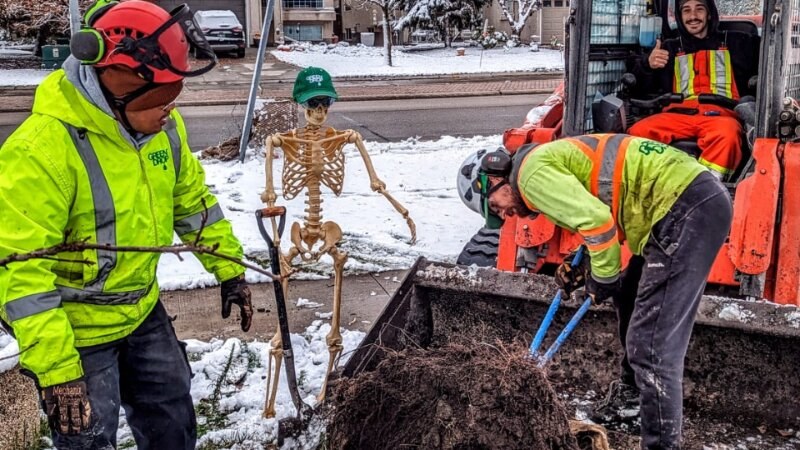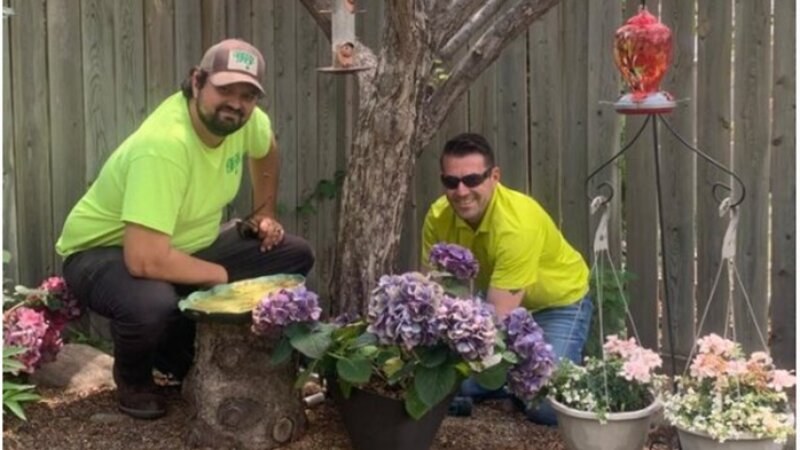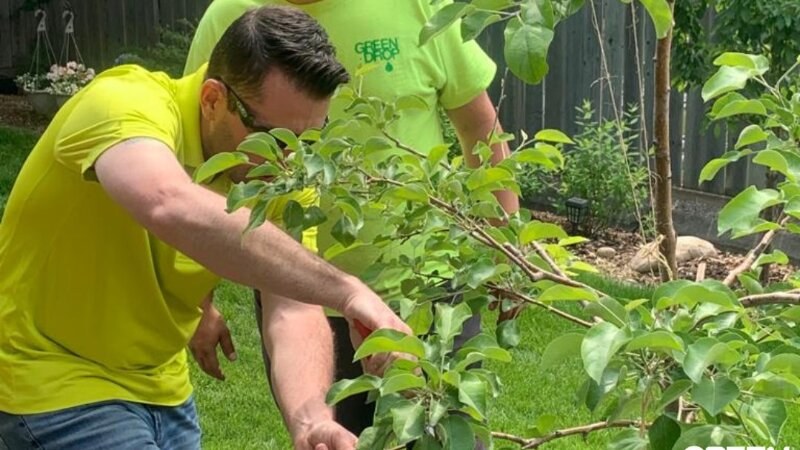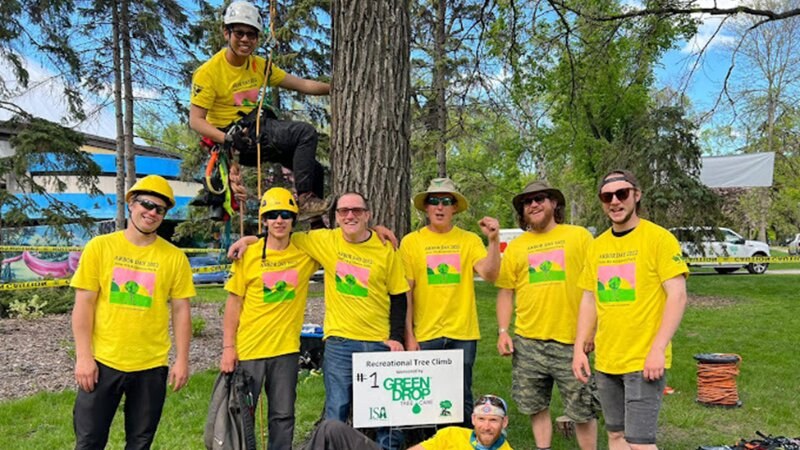Interview with an Arborist: Expert Advice on Tree Trimming in Calgary
Reading time: 8 minutesWhether it's the majestic Elms lining our streets or the Aspens in our backyards, tree trimming is essential to keeping our trees healthy and our homes safe.
But tree trimming isn’t as simple, and that's where the expertise of an ISA-certified arborist comes into play.
Today, we’re digging into what makes professional tree trimming so vital. We’re talking to our Calgary arborists, asking them many burning questions, and getting their advice on tree trimming. Calgary is home to 7 million trees, so it makes sense that you require expert tree care services. Here’s what our arborists had to say.

We Asked Mike: What is an ISA-certified Arborist?
For those who don’t know, the International Society of Arboriculture (ISA) certification is the gold standard for tree care. It's a mark of a true professional who has passed comprehensive exams and stays updated with the latest in arboriculture.
Here at Green Drop, we're proud to have a team of 19 ISA-certified arborists passionate about tree care. We bring the expertise, safety know-how, and a dash of humour (we’re super fun to hang out with!) to ensure that your trees get the best care.
Now, let’s get down to…
We Asked Adam: What Are the Tree Trimming Essentials Calgarians Need to Know?
Trimming your trees is more than just a cosmetic fix—it's a vital check-up that keeps them flourishing year after year.
Why Do You Have to Trim Your Trees?
For Health. Regular trimming promotes strong growth and health. Removing overgrown or dead branches prevents decay-causing fungi from taking hold and allows for better air circulation and sunlight exposure.
For Safety. Unchecked trees can pose a risk. Weak branches may fall, endangering people, power lines, and property, especially during harsh weather. It's all about mitigating risk. A timely trim can prevent a lot of heartache and headaches.
For Aesthetics. Then there's the visual appeal. A well-trimmed tree is symmetrical and balanced and complements your overall landscape design. It's not just about looking pretty; it's about maintaining the value and appeal of your property.
The When of Trimming
When to trim depends mainly on the tree species. The best time to trim in Calgary is often late winter to early spring when trees are dormant.
This timing reduces stress on the trees, resulting in a more vigorous burst of new growth in the spring.
However, there are exceptions based on species and situation:
Deciduous Trees typically fare best when pruned in late winter, before the spring growth starts.
Coniferous Trees can be trimmed in late winter or mid-summer, depending on the desired outcome and tree health.
Fruit Trees require timing specific to their blooming cycle, often needing pruning both post-harvest and pre-spring to maximize fruit production.
Calgary's unique climate can also dictate the best times for tree work. You want to avoid trimming when it's too cold, as the brittleness can lead to damage, or during a disease-prone period when cuts can expose trees to infections.

We Asked Mike: What Are the Signs That Show Your Tree Needs Trimming?
Several tell-tale signs indicate it's time to give your trees a trim. Here are some visual cues and health indicators:
1. Overgrown Branches: If branches are obstructing pathways, touching power lines, or growing too close to your home, it's time for a trim. Not only do these pose a safety risk, but they can also lead to structural issues with your tree.
2. Dead or Broken Limbs: These are unsightly and dangerous. Deadwood can fall anytime, particularly during strong winds or storms, which is pretty common around here.
3. Crossed or Rubbing Branches: When branches cross or rub against each other, they create wounds that can lead to decay and disease. You have a constant friction point, and eventually, something will give.
4. Signs of Disease or Infestation: Look for changes in the foliage, such as discoloured leaves or the presence of fungi, which can indicate more significant health issues. Early detection and trimming away of diseased sections can save a tree's life.
5. Sparse Canopy: A thinning canopy could mean a tree isn't receiving enough light or nutrients. With strategic trimming, we can encourage healthier, more robust growth.
6. Suckers and Water Sprouts: These shoots can drain energy from the main parts of the tree and lead to weak growth. They're like weeds but for trees. They’re sapping nutrients from where they’re most needed.
We Asked Adam: Do I Have To Inspect My Trees Regularly?
We cannot stress the importance of regular tree inspections to catch these signs early. Seasonal inspections can identify potential problems before they become severe, maintaining both the tree's health and your peace of mind.
Remember, the earlier you spot the need for a trim, the easier it is to manage. With regular care, you can keep your trees in optimal condition.
We Asked Mike: What is Green Drop’s Tree Trimming Process?
Tree trimming is a blend of artistry and science, a process we navigate with precision and care.
Here's how we approach tree trimming, with a process fine-tuned for Calgary's urban and suburban landscapes.
Assessment. Before any trimming begins, a thorough assessment of the tree's health, structure, and surrounding area is essential. We look for signs of disease, assess risk factors, and plan cuts to enhance the tree's natural shape.
Planning. Based on the assessment, we develop a trimming plan considering the tree species, desired outcome, and any unique challenges its urban setting poses, such as nearby structures or power lines.
Safety Precautions. Safety is paramount. We secure the area, protecting pedestrians and property from potential falling debris. Personal protective equipment is donned, and tools are inspected to ensure they're up to the task.
Strategic Trimming. We begin by removing any dead or diseased branches to prevent further decay. Cuts are made at the branch collar to encourage proper healing. The idea is to preserve the tree's structural integrity.
Directional Trimming. By selectively trimming, we guide the tree's growth away from structures and power lines, ensuring its future growth is both beautiful and safe.
Clean-up. After trimming, we meticulously clean up all debris and leave the property cleaner than we found. It's our way of showing respect for the tree and the customer's property.

We Asked Adam: How Do We Navigate Tree Trimming In The Presence Of Power Lines?
Trimming trees near power lines is not just complex; it's a high-stakes task where the margin for error is zero. Electricity is unforgiving – even the smallest misstep can lead to catastrophic results.
We follow strict safety protocols and work closely with utility companies to ensure we carry out even the most dangerous trimming jobs without incident.
Our Safety Protocol
1. Risk Assessment: Before any work begins, we conduct a comprehensive risk assessment, considering the tree's proximity to power lines and its potential to conduct electricity.
2. Legal Compliance: There are strict regulations about who can work near power lines and how close they can get. We always adhere to the legal clearance distances.
3. Professional Equipment: We use non-conductive tools and safety equipment for working near electricity.
4. Specialised Training: Our arborists are specially trained to work around power lines, including understanding the physics of electricity and emergency procedures.
5. Power Company Coordination: We coordinate with ENMAX when necessary. They can de-energize and ground lines or install protective coverings to minimize the risk of accidental contact.
6. Controlled Techniques: We employ directional cutting and roping techniques to ensure branches safely fall away from power lines.
We Asked Mike: What are the Common Tree Trimming Blunders to Avoid?
Even with the best intentions, you could inadvertently do more harm than good.
Here are some of the most common tree-trimming mistakes and our arborists' advice on how to avoid them.
Topping Trees
Cutting off the top of a tree, or topping, is harmful and unnecessary. It can weaken growth and increase susceptibility to disease and decay. What grows back is never as strong or as healthy.
Over Pruning
Removing too much foliage disrupts a tree's energy balance, leading to a stressed tree that's vulnerable to pests and diseases. Trees need their leaves for photosynthesis, so over-pruning can starve a tree, much like skipping meals would weaken you.
Flush Cutting
Trimming branches flush against the trunk can damage the tree's natural healing processes. You should always cut just outside the branch collar to promote proper healing.
Wrong Timing
Trimming at the wrong time of year can expose trees to harsh weather conditions or pests. For most trees in Calgary, late winter or early spring is the ideal trimming time.
Using Dull Tools
Using dull tools can cause jagged cuts that are slow to heal and more likely to catch an infection. Sharp tools make clean cuts, which are less traumatic for the tree and heal more quickly.
And that’s a wrap! That’s all our arborist had to say. Have some questions? You can also reach out to us!

Your Calgary Arborist is Just a Call Away!
Mike and Adam have spoken! When it comes to the health of your trees and the safety of yourself and your property, there's no substitute for the expertise of a trained arborist.
Our ISA-certified team of arborists understands Calgary's unique climate challenges. We have the knowledge, tools, and experience to ensure your trees are trimmed and cared for.
Don't let tree trimming become a tale of trial and error. Visit our booking page to schedule a consultation and take the first step toward a healthier, safer, and more beautiful landscape lined with healthy trees!

